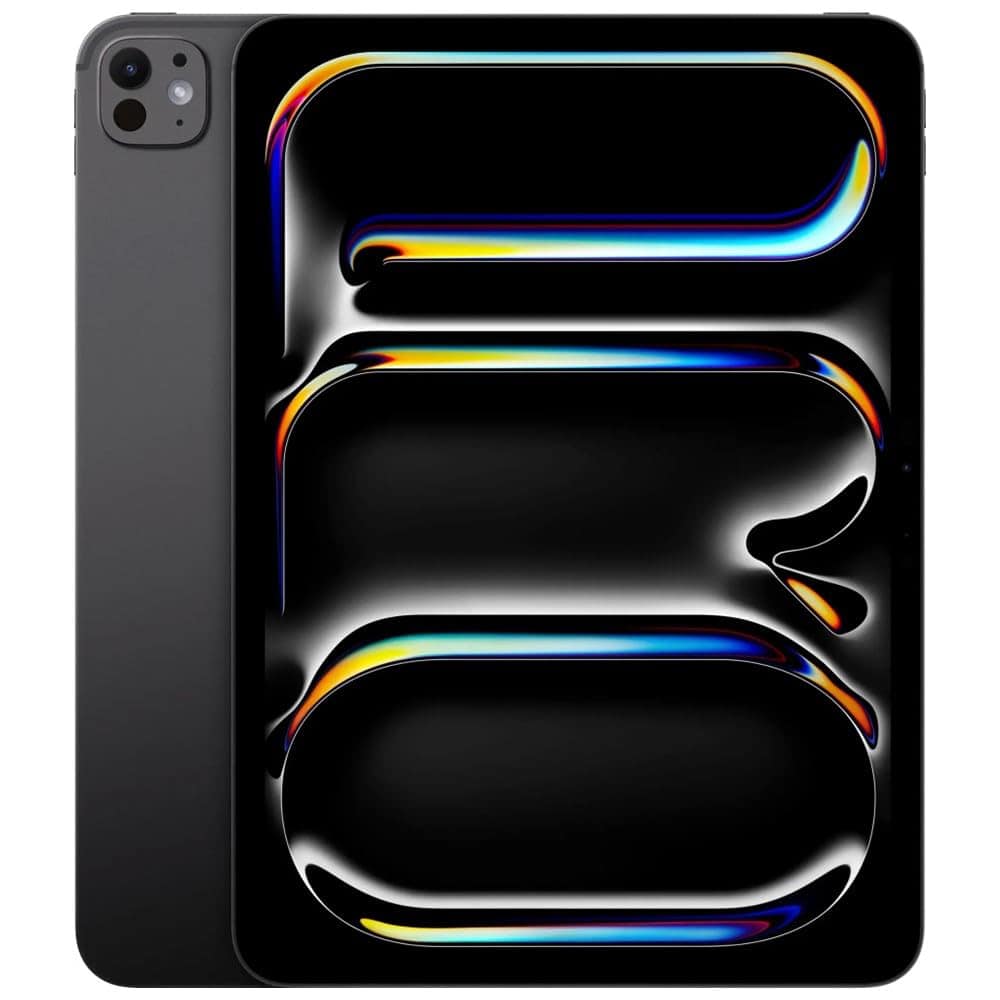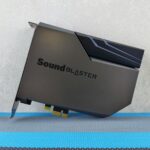Apple’s newest iPad Pro represents a significant leap forward in tablet technology. Released with the powerful M4 chip, this 7th generation device combines exceptional processing power with groundbreaking display technology. The new iPad Pro features an ultra-thin design, advanced Ultra Retina XDR display with tandem OLED technology, and powerful AI capabilities through the M4 chip.
Available in both 11-inch and 13-inch models, the latest iPad Pro maintains Apple’s commitment to portability while pushing performance boundaries. The tablet pairs with new accessories including the Apple Pencil Pro, which offers enhanced functionality compared to previous generations but is only compatible with newer iPad models. Users will appreciate the ProMotion 120Hz refresh rate that ensures smooth scrolling and responsiveness during everyday use.
The iPad Pro supports eSIM technology, continuing Apple’s trend toward wireless connectivity options. Professional users will find the 16GB RAM configuration particularly useful for demanding applications like Affinity Photo, where benchmark testing has shown impressive performance. These specifications make the newest iPad Pro a compelling option for creative professionals and power users who need desktop-level performance in a portable form.

iPad Pro (M4): The Ultimate Performance Tablet
Apple has once again redefined what a tablet can be with the release of the iPad Pro (M4). Launched in May 2024, this latest generation of the iPad Pro brings cutting-edge technology, improved performance, and a sleek new design that pushes the boundaries of what users can expect from a premium tablet.
🔥 Unparalleled Power with the M4 Chip
At the heart of the new iPad Pro (M4) is Apple’s M4 chip, which delivers significant improvements in performance and efficiency. The M4 is built on a 3nm architecture, making it faster and more power-efficient than its predecessor. Whether you’re editing 4K videos, rendering 3D models, or running multiple applications simultaneously, the iPad Pro (M4) handles it effortlessly.
Apple claims that the M4 chip offers up to 50% faster CPU performance and four times the GPU performance compared to the M2, making it the most powerful iPad chip ever.
📱 Ultra Retina XDR Display: OLED Brilliance
For the first time, Apple has introduced Tandem OLED technology in the iPad Pro lineup, delivering a brighter, more vibrant display than ever before. The Ultra Retina XDR display boasts:
✅ 2,000,000:1 contrast ratio for deep blacks and vivid colors
✅ 1000 nits of full-screen brightness (up to 1600 nits for HDR)
✅ ProMotion technology for ultra-smooth scrolling and responsiveness
Available in 11-inch and 13-inch models, the display makes the iPad Pro (M4) a dream device for content creators, graphic designers, and media enthusiasts.
🎨 Slimmest iPad Ever: A Stunning Redesign
Apple has shaved down the thickness of the iPad Pro (M4) to just 5.1mm (13-inch model), making it the thinnest Apple product ever. Despite being lighter and sleeker, the new design doesn’t compromise durability or performance.
📏 iPad Pro (11-inch): 5.3mm thin
📏 iPad Pro (13-inch): 5.1mm thin
The aluminum enclosure remains sturdy, and with Space Black and Silver color options, it looks as premium as it feels.
🎥 Camera & LiDAR: Pro-Level Creativity
The iPad Pro (M4) keeps things professional with a 12MP wide rear camera and a 12MP landscape front-facing ultrawide camera for stunning video calls, content creation, and augmented reality (AR) applications.
Additionally, the LiDAR scanner enhances depth-sensing capabilities, making it perfect for AR apps, 3D modeling, and improved photography in low-light conditions.
🔋 Battery Life & Connectivity: All-Day Performance
Apple promises up to 10 hours of battery life, ensuring you can work, stream, and create throughout the day. Thanks to Wi-Fi 6E and 5G connectivity (on cellular models), you’ll enjoy blazing-fast speeds whether you’re at home or on the go.
✍️ Accessories: Magic Keyboard & Apple Pencil Pro
Apple has also introduced a new Magic Keyboard and the Apple Pencil Pro, enhancing the iPad Pro (M4)’s capabilities:
✔ Apple Pencil Pro: Features a squeeze gesture, haptic feedback, and barrel roll rotation for enhanced precision and control.
✔ Magic Keyboard (2024): Redesigned with a function row, a larger trackpad, and a sleeker aluminum top case for a MacBook-like experience.
🎯 Who Is the iPad Pro (M4) For?
The iPad Pro (M4) is more than just a tablet—it’s a portable powerhouse designed for professionals, creatives, and power users who demand top-tier performance. Whether you’re an artist, video editor, musician, software developer, or student, the iPad Pro (M4) delivers desktop-class power in a tablet form factor.
📌 Final Thoughts: Is It Worth It?
If you’re looking for the most powerful tablet on the market, the iPad Pro (M4) is an easy recommendation. With its M4 chip, Ultra Retina XDR display, and sleek redesign, it offers a near-laptop experience with the versatility of a tablet.
However, if you’re a casual user, the iPad Air (M2) might be a better value. But for professionals and power users, the iPad Pro (M4) is the best iPad Apple has ever made.
Key Takeaways
- The newest iPad Pro features the M4 chip, tandem OLED display technology, and an ultra-thin design that sets new standards for tablet performance.
- New accessories include the Apple Pencil Pro and Magic Keyboard, designed specifically to enhance productivity on the latest models.
- The 7th generation iPad Pro comes in 11-inch and 13-inch sizes with 120Hz ProMotion displays and up to 16GB RAM for professional-grade tasks.
Design and Display
The latest iPad Pro represents a significant evolution in Apple’s tablet design philosophy. The new model combines extreme thinness with powerful display technology and premium materials to create a device that’s both functionally superior and aesthetically striking.
OLED Display Technology
The 2025 iPad Pro introduces OLED technology to Apple’s premium tablet line for the first time. This display upgrade uses a tandem OLED design with two panels working together to deliver exceptional visual performance. The dual-panel approach allows Apple to achieve greater brightness while maintaining efficiency.
OLED brings perfect blacks and infinite contrast ratios to the iPad Pro. Each pixel emits its own light and can turn completely off when displaying black content. This creates more vivid colors and deeper contrast than the mini-LED technology used in previous generations.
The new display also offers improved energy efficiency. When displaying darker content, OLED panels use significantly less power than LCD or mini-LED displays, potentially extending battery life during certain usage scenarios.
Ultra Retina XDR Display
The Ultra Retina XDR display takes the iPad Pro’s visual capabilities to new heights. This advanced display delivers fullscreen brightness of up to 1,000 nits for both SDR and HDR content, with peak HDR brightness reaching an impressive 1,600 nits.
The color accuracy on the Ultra Retina XDR display sets new standards for tablets. Professional users working in photography, video editing, and graphic design will appreciate the precise color reproduction and wide color gamut.
Apple has maintained the ProMotion technology with adaptive refresh rates up to 120Hz. This ensures smooth scrolling, responsive touch input, and fluid motion in games and videos.
Nano-Texture Glass Option
For the first time, Apple offers a nano-texture glass option on the iPad Pro. This specialized finish, previously available only on the Pro Display XDR and select Mac models, provides significant anti-reflective properties in bright environments.
The nano-texture is etched directly into the glass at a nanometer scale. Unlike traditional matte coatings, this approach preserves color accuracy and contrast while diffusing light to reduce glare and reflections.
This finish is particularly valuable for artists, designers, and professionals who work in variable lighting conditions. The nano-texture option enables comfortable viewing and precise work even under bright overhead lights or near windows.
While the nano-texture glass adds to the device’s premium price, many professionals will find the upgrade worthwhile for reducing eye strain during extended use sessions.
Performance
The latest iPad Pro represents a significant leap forward in Apple’s tablet computing capabilities. With the integration of the M4 chip, increased RAM options, and enhanced GPU architecture, the 2024 iPad Pro delivers desktop-class performance in an incredibly thin form factor.
M4 Chip Integration
The 2024 iPad Pro features Apple’s cutting-edge M4 chip, marking the first implementation of this silicon in any Apple device. The M4 processor boasts a 10-core CPU configuration that significantly outperforms the previous generation’s M2 chip. Benchmark tests reveal impressive single-core scores of 3,679 and multi-core scores reaching 14,647, demonstrating substantial improvements in processing capability.
The M4 chip utilizes a hybrid architecture with both performance and efficiency cores. This design allows the iPad Pro to balance power and battery life effectively. When handling intensive tasks like video editing or 3D rendering, the performance cores activate, while routine tasks utilize the efficiency cores to preserve battery life.
Dynamic Caching technology in the M4 chip allocates system memory more intelligently, optimizing resources based on current workloads. This results in smoother multitasking even when running professional apps simultaneously.
RAM and Storage Options
The 2024 iPad Pro comes equipped with 16GB of RAM in all configurations, a substantial upgrade from previous generations. This increased memory allocation allows for more complex workflows and smoother performance when using memory-intensive applications.
Storage options for the new iPad Pro start at 256GB, replacing the 128GB base model from previous generations. This acknowledges the growing size of professional applications and media files.
Additional storage configurations include 512GB, 1TB, and 2TB options. The higher capacity models benefit creative professionals who work with large files such as 4K video projects or extensive graphic design assets.
The faster memory bus in the M4 chip allows for improved data transfer speeds between storage and RAM. This translates to quicker app loading times and more responsive performance when working with large files.
GPU and Processing Power
The M4 chip integrates a powerful GPU designed specifically for the iPad Pro’s needs. Graphics performance shows significant improvements over previous generations, particularly beneficial for 3D modeling, video editing, and gaming applications.
The neural engine within the M4 chip has been enhanced to handle AI and machine learning tasks more efficiently. This accelerates features like object recognition in photos, voice processing, and other AI-driven capabilities.
When rendering complex 3D models or editing high-resolution video, the iPad Pro maintains consistent performance without throttling. This stability is crucial for professionals who depend on reliable processing power for deadline-driven work.
Battery efficiency has improved despite the performance gains. The iPad Pro can maintain high performance levels while still delivering all-day battery life under typical usage conditions. This balance makes it a truly portable professional workstation without compromising power.
Software and AI
The iPad Pro’s newest generation shines with its software capabilities and artificial intelligence features. Apple has integrated cutting-edge technology that leverages the powerful M4 chip for enhanced performance and revolutionary AI experiences.
iPadOS Capabilities
The latest iPad Pro runs the most advanced version of iPadOS, specifically optimized to take advantage of the M4 chip’s processing power. The operating system offers multitasking features that allow users to run multiple apps simultaneously with minimal performance impact.
Users can now enjoy improved split-screen capabilities and more intuitive gesture controls. The Files app has been enhanced with better organization tools and faster search functionality.
Stage Manager provides a more desktop-like experience with resizable windows and easier navigation between apps. This makes the iPad Pro more versatile as a productivity tool.
The software also includes advanced handwriting recognition through Apple Pencil Pro integration, converting handwritten notes to text with remarkable accuracy.
Machine Learning Applications
The M4 chip in the newest iPad Pro features Apple’s most powerful Neural Engine to date, dramatically improving machine learning performance. This enables complex computational photography and video editing capabilities previously available only on high-end computers.
On-device machine learning allows for faster photo processing, enhanced video stabilization, and improved object recognition without sending data to cloud servers.
Creative professionals benefit from ML-powered tools in apps like Procreate, Adobe Photoshop, and Final Cut Pro. These tools can intelligently select subjects, enhance images, and provide smart editing suggestions.
The Neural Engine also powers advanced biometric authentication, making Face ID faster and more secure than in previous generations.
Apple Intelligence Features
Apple Intelligence represents a major leap forward for the iPad Pro, with features designed to enhance productivity and creativity. These AI capabilities work seamlessly across the system and within apps.
For text work, Apple Intelligence offers smart writing assistance with context-aware suggestions and improved dictation accuracy. It can summarize long documents and help refine writing style based on content type.
Key Apple Intelligence Features:
- Smart photo editing with subject recognition
- Automatic video editing suggestions
- Voice isolation during video calls
- Context-aware Siri interactions
- Real-time language translation
- Intelligent noise cancellation
The system also includes predictive features that learn user habits over time. This allows the iPad Pro to anticipate needs, such as suggesting apps based on time of day or location.
Apple has designed these features with privacy in mind. AI processing happens on-device whenever possible, keeping sensitive data secure.
Camera System
The iPad Pro’s camera system combines advanced hardware with intelligent software features to deliver professional-grade photography and videography capabilities. The latest generation incorporates significant upgrades that enable users to shoot, edit, and share content all on one device.
Center Stage Technology
Center Stage uses the iPad Pro’s front-facing camera and machine learning to keep users perfectly framed during video calls. This feature automatically adjusts the camera view to keep subjects centered even as they move around the room.
When multiple people join the frame, Center Stage intelligently recognizes them and smoothly zooms out to include everyone. This technology has become particularly valuable for remote work scenarios and family video calls.
The system works seamlessly with popular video conferencing apps like FaceTime, Zoom, and Microsoft Teams. The front camera placement has been optimized in landscape orientation, making it more natural for conference calls when the iPad is positioned horizontally.
Center Stage doesn’t require any manual adjustments from users. It functions automatically once enabled, creating a more engaging and professional video calling experience.
High-Resolution Video Capture
The iPad Pro’s camera system supports impressive 4K ProRes video recording, giving content creators professional-grade video capabilities in a portable device. This high-resolution capture preserves exceptional detail and color accuracy.
The 12MP back camera delivers vibrant Smart HDR images with improved textures and enhanced detail, even in challenging lighting conditions. Video stabilization technology ensures smooth footage when recording on the move.
Four studio-quality microphones capture clear, directional audio to complement the high-resolution video. This audio system minimizes background noise while prioritizing the subject’s voice.
The M4 chip powers advanced computational photography features that enhance video quality in real-time. These improvements are particularly noticeable when shooting in low-light environments.
Users can edit 4K footage directly on the iPad Pro using apps like iMovie and LumaFusion. The powerful processor handles these demanding tasks without lag or performance issues.
True Tone Flash and Document Scanning
The True Tone flash adapts to ambient lighting conditions, producing natural-looking illumination for photos. This system analyzes the scene and adjusts both intensity and color temperature to match the environment.
Unlike standard flashes that often create harsh lighting, True Tone technology balances exposure to maintain natural skin tones and accurate colors. This feature is especially helpful when taking portraits in less-than-ideal lighting situations.
The camera system also excels at document scanning with its LiDAR Scanner that precisely maps the environment. This enables the iPad Pro to automatically detect document edges and correct perspective distortion.
The scanning capability allows users to digitize text documents, receipts, and handwritten notes with remarkable clarity. Once scanned, documents can be marked up with Apple Pencil or converted to editable text using optical character recognition.
Business professionals particularly appreciate this feature for capturing whiteboards during meetings or processing paperwork while away from the office.
Connectivity and Accessories
The latest iPad Pro model offers extensive connectivity options and accessory support that significantly enhance its functionality for professional and creative users. The device incorporates cutting-edge wireless technology alongside versatile port options and compatibility with Apple’s premium accessories.
USB-C Port Expansion
The newest iPad Pro features a USB-C port with Thunderbolt capabilities, representing a major upgrade from previous generations. This high-speed connection allows for data transfer rates up to 40Gbps, enabling seamless connection to external displays with up to 6K resolution.
The port supports a wide range of peripherals including external storage devices, cameras, and audio interfaces. Professional users can connect multiple accessories simultaneously using USB-C hubs or docking stations.
Power delivery through the USB-C port enables faster charging compared to older iPad models. The port also supports video output for presentations and content creation, making it ideal for professional environments.
For content creators, the expanded USB-C functionality allows direct imports from cameras and other devices without adapters. This streamlined workflow saves time and reduces the need for additional equipment.
Wi-Fi 6E and Bluetooth Enhancements
The iPad Pro incorporates Wi-Fi 6E technology, providing access to the 6GHz frequency band in addition to the standard 2.4GHz and 5GHz bands. This expansion offers less congested wireless channels and significantly improved performance in dense environments.
Download speeds can reach theoretical maximums of 2.4Gbps under ideal conditions. This makes large file transfers, cloud syncing, and streaming high-resolution content notably faster and more reliable.
The device includes advanced Bluetooth capabilities for connecting multiple peripherals simultaneously. Audio latency has been reduced for wireless headphones and speakers, improving the experience for media consumption and audio production.
Network security has been enhanced with the latest WPA3 protocols. The improved wireless performance is particularly beneficial for users who frequently participate in video calls or stream content.
Compatibility with Apple Pencil and Magic Keyboard
The new iPad Pro is fully compatible with the Apple Pencil Pro, Apple’s most advanced stylus to date. This premium accessory offers pressure sensitivity, tilt recognition, and new hover functionality that previews marks before they’re made on the screen.
The Apple Pencil Pro introduces haptic feedback that simulates the feeling of drawing on different surfaces. It also features a squeeze gesture that provides quick access to tools without interrupting the creative flow.
The latest Magic Keyboard (2nd-gen) designed for the iPad Pro provides a premium typing experience with full-size backlit keys and a precision trackpad. The floating cantilever design allows for adjustable viewing angles while maintaining stability.
Both accessories connect seamlessly with the iPad Pro. The Apple Pencil Pro attaches magnetically to the side of the iPad for charging and pairing, while the Magic Keyboard connects via the Smart Connector for instant power and data transfer without Bluetooth pairing.
These premium accessories transform the iPad Pro from a consumption device into a powerful creation tool for artists, designers, and professionals across various industries.
Audiovisual Features
The iPad Pro’s newest generation delivers exceptional audiovisual capabilities that significantly enhance the user experience. The device incorporates advanced haptic feedback technology and premium audio systems that work together to create an immersive environment.
Haptic Engine Feedback
The new iPad Pro integrates an advanced Haptic Engine that provides tactile feedback throughout the interface. This technology creates subtle vibrations that respond to different touch inputs, giving users physical confirmation of their actions. The system works particularly well with the Apple Pencil Pro, allowing artists and note-takers to feel different textures when drawing or writing.
Users can feel distinctive haptic patterns that correspond to various app functions. When editing photos or videos, the Haptic Engine provides feedback that mimics the feeling of adjusting physical controls.
The sensitivity levels can be customized in the settings menu to match personal preferences. This feature adds a new dimension to gaming experiences as well, with precise vibrations that correspond to in-game actions.
Speaker Quality and Spatial Audio
The iPad Pro features a sophisticated four-speaker audio system that automatically adjusts based on how the device is held. These speakers deliver remarkably clear sound with deep bass and crisp highs, making the iPad excellent for media consumption and content creation.
Spatial Audio technology transforms the listening experience by creating a three-dimensional soundstage. When watching movies or TV shows, dialogue sounds as if it’s coming directly from the screen while ambient sounds surround the user.
The system supports Dolby Atmos content, bringing cinema-quality audio to the portable device. For music enthusiasts, the speakers reproduce detailed instrument separation and accurate vocal positioning.
Professional content creators will appreciate the studio-quality microphones that capture clean audio input for recording or video calls. The device’s advanced audio algorithms also reduce background noise during calls, ensuring clear communication.
Professional Usage
The iPad Pro’s newest generation transforms it into a powerful tool for creative professionals. Apple’s M4 chip and advanced display technology make it suitable for demanding workflows that previously required desktop computers.
Production Studio Capabilities
The iPad Pro now serves as a portable production studio for creative professionals. DaVinci Resolve’s arrival on iPadOS marks a significant shift, enabling professional video editors to perform intensive work on the go. The M4 chip provides desktop-class performance in an ultra-thin form factor that’s easy to transport between locations.
The expansive 13-inch model features Apple’s most advanced display technology, delivering exceptional color accuracy and brightness essential for photo and video editing. Artists and designers benefit from Apple Pencil integration with precise pressure sensitivity and minimal latency.
Audio professionals can connect multiple peripherals through USB-C, turning the iPad Pro into a mobile recording studio. The device’s processing power handles complex audio production tasks with ease.
Advanced Multitasking
The iPad Pro excels at professional multitasking through iPadOS’s refined interface. Users can run multiple professional applications simultaneously without performance degradation. The system allows for side-by-side app viewing, making reference work and cross-application workflows seamless.
Stage Manager provides a desktop-like multitasking experience with resizable windows and improved external display support. This feature particularly benefits professionals who need to monitor multiple information streams or applications.
The Magic Keyboard transforms the iPad Pro into a laptop alternative with a responsive typing experience and integrated trackpad. This setup enables professionals to switch between touch, keyboard, and pencil input methods based on specific tasks.
File management improvements allow for professional-grade workflows with external storage devices and network locations. These capabilities address previous limitations that prevented some professionals from fully adopting iPad as their primary work device.
Comparative Analysis
Apple’s iPad Pro lineup offers significant advantages over other models, with distinctive features for professionals and power users. The newest generation introduces substantial upgrades in performance, display technology, and capabilities compared to previous models and other iPad variants.
iPad Pro vs iPad Air
The iPad Pro significantly outperforms the iPad Air in processing power. With the M2 chip (or newer M3 in the 2024 models), the Pro delivers up to 35% faster graphics performance than the Air’s older chipset. This difference becomes noticeable in demanding tasks like video editing and 3D rendering.
Display quality creates another major distinction. The newest iPad Pro features OLED technology (branded as “Tandem OLED”), replacing the previous LCD and mini-LED displays. This provides deeper blacks, better contrast, and improved color accuracy compared to the iPad Air’s standard Liquid Retina display.
Storage options also differ substantially. The Pro starts at 256GB and offers configurations up to 2TB, while the Air typically maxes out at 256GB or 512GB depending on the model.
Professional users benefit from the Pro’s additional features including Thunderbolt ports, ProMotion 120Hz refresh rate, and better camera systems. These advantages justify the higher price point for those needing maximum performance.
11-Inch vs 13-Inch Models
The size difference between these models significantly impacts user experience and portability. The 11-inch iPad Pro weighs approximately 1.03 pounds, making it notably lighter than the 13-inch model at around 1.5 pounds.
Battery performance shows some variation between sizes. Interestingly, despite having a larger battery, the 13-inch model often delivers similar runtime to the 11-inch version due to its larger display requiring more power. Testing shows approximately 10 hours of mixed usage for both models.
Display quality remains consistent across both sizes in terms of technology, with both featuring the new OLED screens in the latest generation. However, the 13-inch model provides 38% more screen real estate, benefiting tasks like digital art, split-screen multitasking, and media consumption.
Price represents a significant deciding factor. The 13-inch model typically costs $200-300 more than its 11-inch counterpart with identical specifications, making the smaller version a better value for budget-conscious buyers.
iPad Mini and Standard iPad Alternatives
The standard iPad (10th generation) serves as an excellent alternative for casual users. At nearly half the price of the Pro models, it still provides solid performance for everyday tasks like web browsing, media consumption, and light productivity work.
Battery life actually favors these alternatives. The standard iPad delivers nearly 12 hours of use compared to the Pro’s 10+ hours, making it better suited for extended use without charging.
The iPad Mini offers unique advantages with its 8.3-inch display. Its exceptional portability makes it ideal for reading, note-taking on the go, and one-handed use. The A15 Bionic chip delivers surprisingly capable performance despite the compact size.
Performance gaps are noticeable but context-dependent. While the Pro models with M-series chips dramatically outperform the A-series processors in the standard and Mini iPads, many users won’t encounter these limitations in typical usage scenarios.
Storage options start lower on these alternatives (64GB base models), which can become restrictive for users with large media libraries or numerous applications.
Market Context
The iPad Pro’s market position reflects Apple’s strategy in the premium tablet space. Current industry trends show increasing demand for high-performance tablets, with the upcoming 8th generation iPad Pro positioned to set new standards in this competitive landscape.
Pricing and Value
The 2025 iPad Pro lineup is expected to maintain Apple’s premium pricing strategy. Current Pro models with OLED displays and M4 chips launched in May 2024 start at $999 for the 11-inch model and $1,299 for the 13-inch version.
The anticipated M5-powered iPad Pro will likely command a similar price point, possibly with a slight increase to reflect the performance improvements. These devices represent Apple’s highest tier in their tablet hierarchy.
For budget-conscious consumers, older iPad Pro generations typically see price reductions when new models launch. This creates tiered pricing options across the iPad family.
The value proposition centers on professional-grade performance. The Pro models justify their premium through specialized features like ProMotion displays, superior processing power, and Apple Pencil integration that benefit creative professionals and power users.
Competitor Analysis
Samsung’s Galaxy Tab S series remains the iPad Pro’s primary competitor in the premium tablet space. Samsung’s offerings typically undercut Apple’s pricing while providing comparable specifications and Android’s flexibility.
Microsoft’s Surface Pro line competes from a different angle, emphasizing laptop-replacement functionality with Windows OS. This positions Surface as more productivity-focused compared to iPad Pro’s content creation strengths.
Budget alternatives from manufacturers like Lenovo and Amazon offer basic tablet functionality at significantly lower prices. These devices capture the entry-level market but don’t compete directly with iPad Pro’s professional capabilities.
The upcoming 8th generation iPad Pro with M5 chip will face a market where competitors have closed some of the performance gap. However, Apple’s integrated ecosystem and app optimization continue to provide competitive advantages that rival manufacturers struggle to match.
Technical Specifications
The latest iPad Pro introduces groundbreaking hardware improvements with the M4 chip, advanced display technology, and impressive battery performance. Apple has pushed the boundaries of tablet computing with this newest generation.
Chipset and GPU Architecture
The new iPad Pro features Apple’s M4 chip, built on 3-nanometer technology, representing a significant leap in processing capability. This architecture allows for more transistors in a smaller space, improving both performance and energy efficiency. The M4 chip delivers up to 30% faster CPU performance compared to the previous M2 generation.
The GPU in the M4 iPad Pro has been completely redesigned with enhanced cores that provide remarkable graphics processing power. This translates to smoother rendering for complex 3D applications, gaming, and video editing tasks.
Apple’s Neural Engine has also been upgraded, now processing up to 18 trillion operations per second, enabling more advanced machine learning tasks right on the device. This improvement supports sophisticated features like advanced photo editing and real-time language translation.
| M4 Chip Specifications | Details |
|---|---|
| Architecture | 3-nanometer technology |
| CPU Performance | Up to 30% faster than M2 |
| GPU | Enhanced multi-core design |
| Neural Engine | 18 trillion operations per second |
Display Specifications
The iPad Pro comes in two sizes: 11-inch and 13-inch models, both featuring advanced OLED display technology that Apple calls the Ultra Retina XDR display. This marks the first time Apple has used OLED technology in its iPad lineup, providing exceptional contrast ratios and true blacks.
The display supports ProMotion technology with refresh rates up to 120Hz, adapting dynamically based on content. This ensures smooth scrolling and responsive touch inputs while conserving battery when displaying static content.
Resolution on the 13-inch model reaches an impressive 2732 x 2048 pixels with 264 pixels per inch. The display supports P3 wide color gamut and True Tone technology for accurate color representation in various lighting conditions.
Both models offer peak brightness of 1000 nits for standard content and up to 1600 nits for HDR content. The screens are coated with a fingerprint-resistant oleophobic coating and feature anti-reflective properties for better outdoor visibility.
Battery Life and Efficiency
Battery performance on the new iPad Pro maintains Apple’s high standards despite the more powerful hardware. According to Apple’s testing conducted in March and April 2024, the devices deliver up to 10 hours of web browsing on Wi-Fi or watching video.
The efficiency gains from the 3-nanometer M4 chip help offset the power requirements of the new OLED displays. The system intelligently manages power consumption based on usage patterns and active applications.
Fast charging is supported through the USB-C port, with the ability to reach 50% battery in approximately 30 minutes when using a 30W adapter or higher. This quick charging capability is particularly valuable for professionals who need to recharge between meetings or locations.
Battery capacity varies between models, with the 13-inch version housing a larger battery to compensate for its bigger screen. The improved power management system extends useful battery life even during processor-intensive tasks like video editing or 3D rendering.







